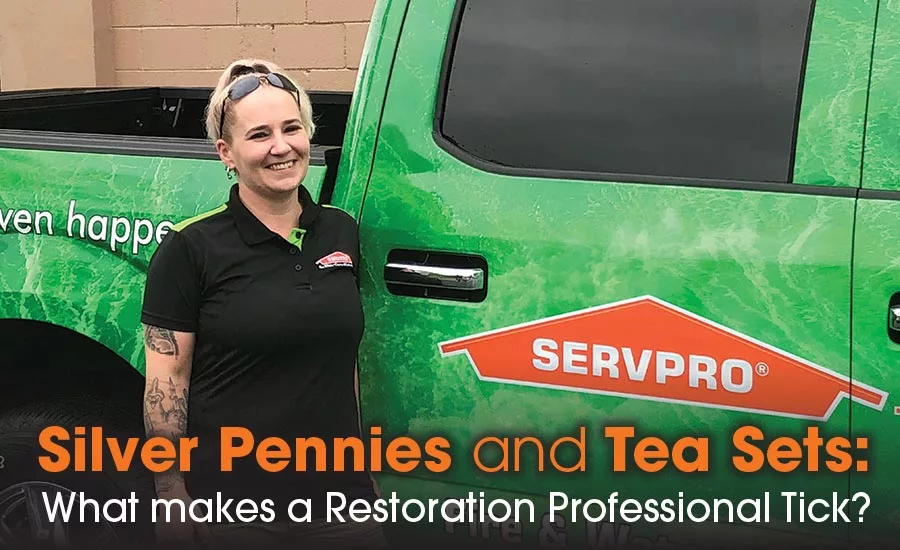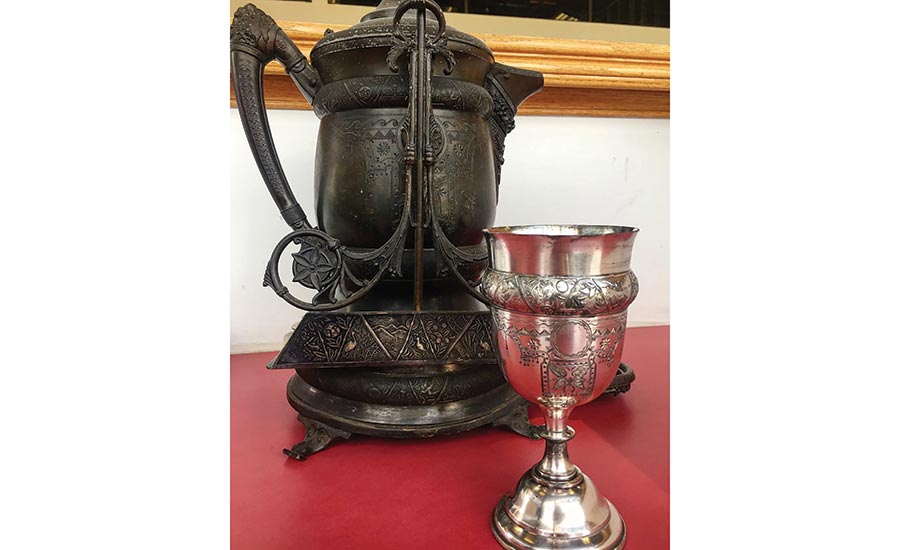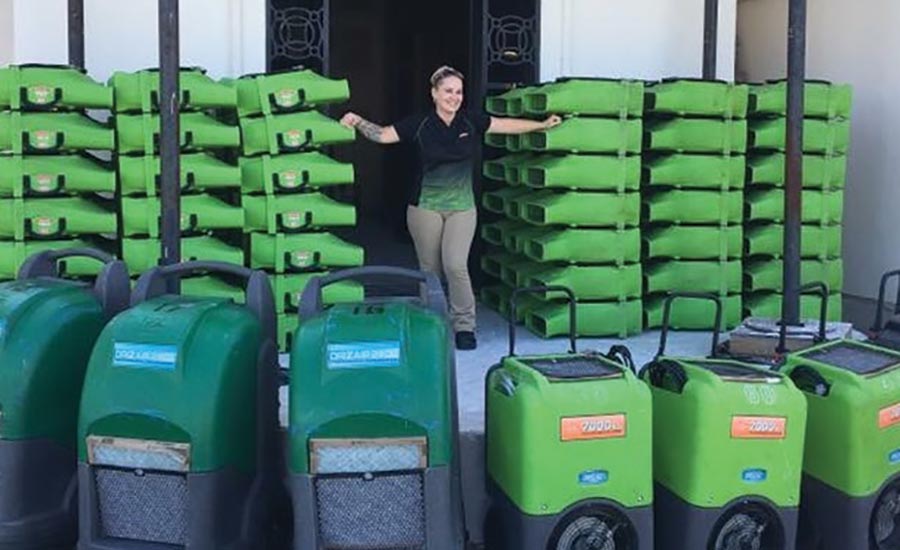Silver Pennies and Tea Sets: Finding Passion in Contents Cleaning

Meet Jennifer George, a full services contents restoration professional for SERVPRO in Ohio’s West Mahoning County. Being a parent of four young children can be tough to find quality work-life balance but Jennifer’s can-do attitude has seen her 11-year career blossom due in no small part to hands-on training and the franchise’s use of advance technology in washing systems and high operational standards. Jennifer’s company is a member of the ECONA network of R&R operators that provides training, business leads and carrier support services to their 265 members.
Jennifer, what prompted you to get into this business in the first place?
Jennifer George: I learned about this job from a family member who had worked there. To be honest, I had never heard of restoration services applied to water or fire damage and helping people really interested me as a career.
What kind of training did you receive?
Jennifer George: I was fortunate to receive multiple types of training. I am IICRC certified in fire and smoke restoration, water damage restoration and applied structural drying. I also have certifications in carpet and upholstery cleaning.
The IICRC training is useful when it comes to fabrics or personal belongings, even structural cleaning. The training helped me grow with the company and it also instructed how to work with customers when confronted with different types of challenging scenarios.
What would you say are the characteristics that make for a good contents restoration pro?
Jennifer George: I would say my biggest attribute, or what makes me a caring person, is believing that I am truly making a difference to the homeowner. You want to under-promise but overachieve. That is the biggest impact we have on our clients and it is a great feeling to do that for victims of loss. You need to relate to what the customer is going through. You need to be able to put yourself in their shoes and realize the traumatic experience they are suffering and you need to be able to understand that. We need to help these people feel comfortable and restoring what we can restore for them to save their lives is most important. We also need to rely on good R&R technology. The Esporta wash system and the ultrasonic equipment are prized and heavily utilized at our facility, usually running up to 20 hours daily.
Turning to highly cherished items, it would seem that restoring sentimental items would be the highest priority for customers.
Jennifer George: I would rate photographs high on the list of precious items because those represent family history and nobody wants to lose that. Photographs and photo albums that have been completely submerged in different types of contaminants are especially hard to salvage. They’re wet or they’re moldy. I have been successful at restoring those by putting them into a special-purpose drying chamber that is sealed off for proper dehumidification. Soot can stain the photos and when wet they can stick together. By using different types of cleaning methods, I’ve been able to restore photographs and also remove smoke odor. Not an easy process, since ultrasonics won’t solve the problem because of the ink. Photographs involve more hands on work. Photos that sat in a damp environment or been submerged in water can have permanent damage, but with a fast response time we are usually able to save them.
What would you say is another problem item to clean that is dear to the homeowner?
Jennifer George: Believe it or not, sometimes we run into a pile of cash. As you can imagine, money is always a sensitive thing especially when it involves rare coins or valuable collections. We try not to take money off the job site because it can make customers uncomfortable. For the customers’ peace of mind we choose not to remove it from their possession and instead bring dehumidifier equipment into the home. With the windows sealed and the doors shut we turn the entire house into a drying chamber. Not only are we drying the structure of the house but we can also dry out their personal items and belongings.
Any interesting experiences with money that you’d like to share?
Jennifer George: I did a job where there was an elderly man who had Alzheimer’s. He would drop money on the floor and not realize it. He would hide it from himself. It was a water damage case. We collected the money and set up a designated area where we laid out the cash for him to see and have the chance to count it. We restored the money without having to remove it from his house.
I’ve done lots of homes where people have collectible money, money from foreign countries or rare gold coins. For instance, during the WWII, or money during certain time periods from the early fifties and late forties was valuable for their markings. You might find a $5 bill that could be worth a thousand just because of the year it was printed. We come across coins more often than the bills. Even pennies at one point used to be made from solid silver. During the mid-forties they used a lot of copper to make bullets. They made pennies out of silver so they could use copper for the armed forces. These silver pennies are very valuable because of their highly limited print run. Silver pennies covered in soot can actually discolor the silver. It’s important that we try to clean those as soon as possible to keep their value.

Precious metals is an interesting category. How do you go about cleaning that?
Jennifer George: There’s a large emerging market for precious items that have not been necessarily damaged by soot. Items such as heirlooms and collectible antiques that someone has been waiting their entire lives to have restored to a better condition. When these items are brought to our attention we can apply knowledge to bring these objects to their fullest potential. It’s a combination of professional expertise, identifying next steps, and then understanding the cleaning systems and what can be done to bring these items back to their fullest potential.
Various different types of dishes made of brass or silver that are known to tarnish over the years can cause a lot of damage if left untreated. There was an antique silver tea set that was dated from the late 1800s that had been in a family for a long time. It sustained heavy damage by fire that burnt most things beyond recognition. Soot has a high acidic level. It can cause permanent staining to stainless steel, silver, brass, even mirrors. Acidity can cause an orange haze if soot is left on too long.
Because it was so heavily contaminated we had to do a light wipe on the product to get that initial layer off of it. We want the contaminants to stick to the cloth instead of contaminating the item itself. And it did take several times running through the ultrasonic machine to successfully remove all the contaminants without actually damaging it. Given the age of the item, that was a big win for us. We were really excited to save that for the family because they had already lost so much.
What would you say is a difficult category to restore?
Jennifer George: I would say the biggest challenges have been in electronics because it is a delicate process. You have to make sure they are dried out properly. You have to examine the appliance, such as a toaster. When you run it through the system, make sure it is dried properly and works.
How much of a discussion is there between you and the homeowner in regards to specialty items?
Jennifer George: You have to take the time and the care to understand the item and its’ importance to the individual. How badly do they want it restored? It’s not about rushing it through a machine, it’s about taking the time to do what’s necessary. It can take an individual using a microfiber cloth to do a first clean, but also we’ve gone as far as using Q-tips to get into hard to reach places. Ultimately, it’s the care taken from start to finish; from picking the item up, packing it, bringing it to the warehouse, unpacking it, setting it up in our cleaning station and the individual handling that item with care.
What is the main takeaway for adjusters and insurers?
Jennifer George: We want to get claims professionals to think about the value of restoration and its association to consumer cost savings in premiums and to insurers. Because of today’s technology, household goods never thought restorable previously are now restorable. Who would think that you can restore a television set? It’s a good feeling to open everybody’s eyes and say, hey, your stuff is not destroyed, we can help you save what you thought was lost forever.
Looking for a reprint of this article?
From high-res PDFs to custom plaques, order your copy today!







